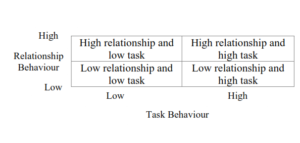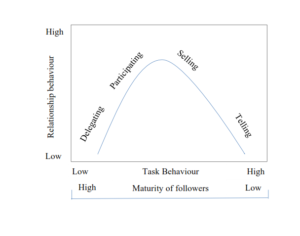2. Hersey-Blanchard’s Situational Model
Hersey and Blanchard feels that the leader has to match his leadership style according to the needs of maturity of subordinates which moves in stage and has a cycle. Therefore, this theory is also known as life-cycle theory of leadership.
There are two basic considerations in this model:
i. Leadership Styles
ii. Maturity of Subordinates
i. Leadership styles
Based on relationship behavior and task behavior leadership styles may be classified into four categories : relationship behavior and task behavior. Relationship behavior is determine by socio-emotional support provided by the leader. Task behavior is seen in terms of the amount of guidance and direction provided by the leader. Combination of these two dimensions results into four leadership styles as shown I the following figure:
ii. Maturity of Subordinates
Maturity in this model is the ability and willingness of the people for directing their own behavior. All persons tend to be more or less mature in relation to a specific task, function, or objective that a leader is attempting to accomplish through their efforts. When both components of maturity i.e. ability and willingness are combined , we can get four combinations:
a) Low ability and low willingness-low maturity
b) Low ability and high willingness-low to moderate maturity
c) High ability and low willingness-moderate to high maturity
d) High ability and high willingness-high maturity
Combining Leadership Styles and Maturity
If we combine leadership styles and maturity, that is the leadership style which is appropriate at a given level of maturity, we may arrive at the relationship between the two as shown in the figure below:
Thus, there are four leadership styles, each being appropriate to a specific level of maturity. The four leadership styles are:
i. Delegating
This is a low task and low relationship styles. The leader allows the group members to take responsibility for any task decisions. This style can be suitable when the followers have the capability, willingness, commitment and confidence to do the tasks entrusted. In this style, the task responsibility and control is with the leader, especially regarding when an dhow the leader should be involved. This style can work well when the followers’s readiness is high.
ii. Participating
This is a low task and high relationship style. Here, the leader focuses primarily on frank and open discussions with the employees and collective decisions on task planning and accomplishment. This style is preferred when the leaders have the ability, but not the willingness and confidence to successfully complete the tasks. This style is best when the follower’s readiness is low to moderate.
iii. Selling
This is a high task and high relationship style.This style is tried out when the followers lack adequate capability, but keep high commitment and willingness to do the task entrusted. Here, the leader just explains the task direction in an encouraging and persuasive manner. This style is most suitable when the followers’s readiness is moderate to high.
iv. Telling or coaching
This is a high task and low relationship style. Here, the leader defines the follower’s role, provides clear direction and also training, if necessary. They also extend personal, social and emotional support to them. leaders tend to adopt this style when their followers are short on ability, willingness and confidence. This style can be appropriate when follower’s readiness is low.
According to this model, leaders should change their leadership styles as their followers change over time. This model also believes that when appropriate styles are adopted by the leaders,especially when the followers are in low-readiness situation, then these followers will grow in maturity and readiness over a period of time. However, adequate research has not been carried out on this model eve though it remains intuitively appealing.


